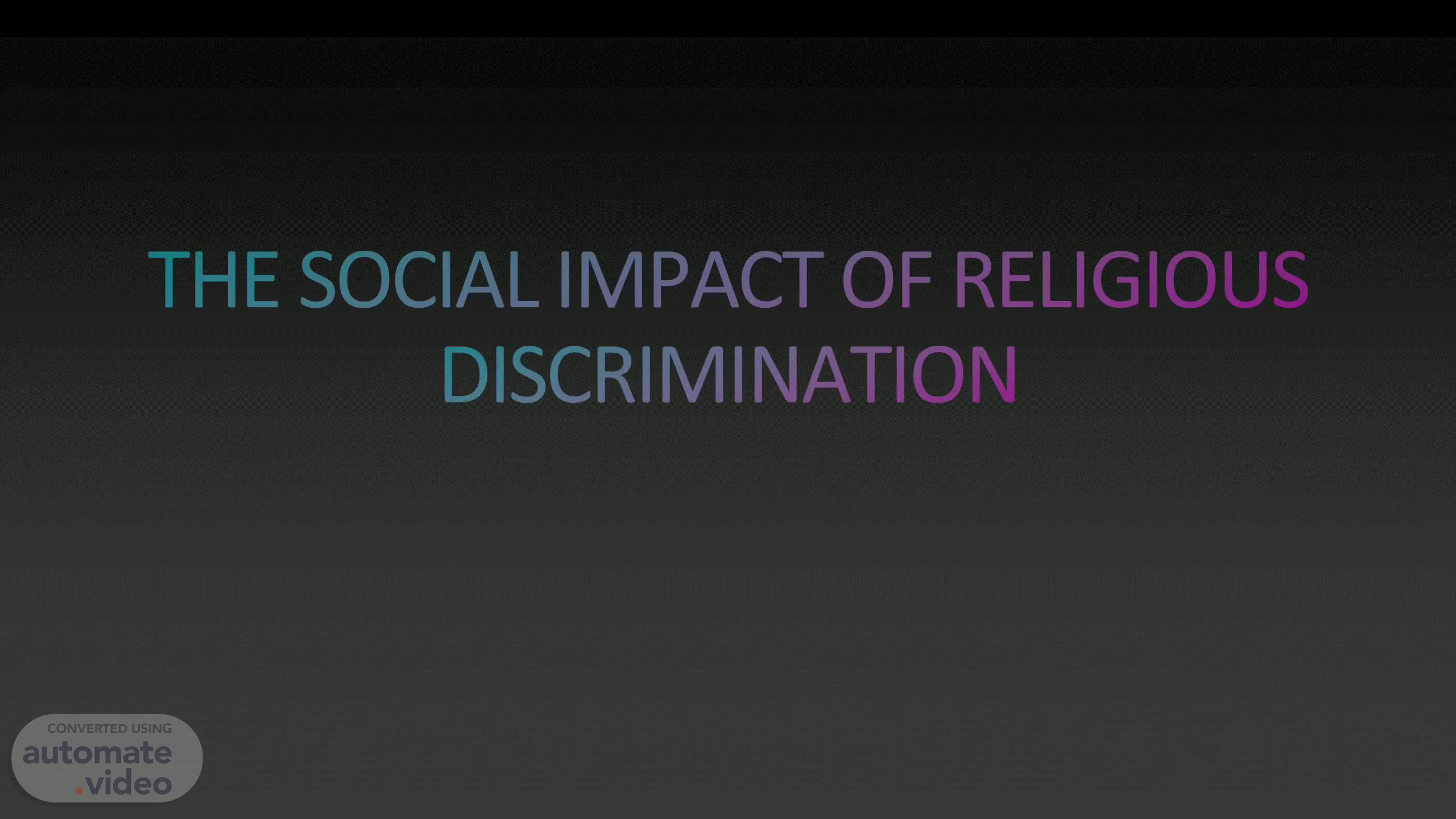
THE SOCIAL IMPACT OF RELIGIOUS DISCRIMINATION
Scene 1 (0s)
[Audio] THE SOCIAL IMPACT OF RELIGIOUS DISCRIMINATION.
Scene 2 (6s)
[Audio] Introduction Prejudice Violence Inequality Impact on Communities Conclusion.
Scene 3 (20s)
[Audio] Introduction Religion has been a source of conflict and discrimination throughout history, leading to social problems that continue to affect individuals and communities today. This presentation will explore some of the social problems that arise from religion discrimination, including prejudice, violence, and inequality..
Scene 4 (42s)
[Audio] Prejudice One of the most common social problems resulting from religion discrimination is prejudice, which can manifest in various forms such as stereotypes, bias, and bigotry. Prejudice can lead to negative attitudes towards individuals or groups based on their religion, and can result in exclusion, marginalization, and even hate crimes..
Scene 5 (1m 5s)
[Audio] Violence Religious conflicts have often resulted in violence, both on an individual and societal level. Acts of violence can range from verbal harassment to physical assault, and can be motivated by religious differences or perceived threats to religious beliefs or practices..
Scene 6 (1m 25s)
[Audio] Inequality Religion discrimination can also lead to systemic inequalities, particularly in areas such as education, employment, and housing. Individuals of certain religions may face barriers to accessing opportunities or resources, and may be subject to discriminatory policies or practices..
Scene 7 (1m 47s)
[Audio] Impact on Communities Religion discrimination not only affects individuals, but can also have a significant impact on communities as a whole. Social problems such as prejudice, violence, and inequality can erode trust between different religious groups, and can hinder efforts towards building inclusive and cohesive societies..
Scene 8 (2m 10s)
[Audio] Conclusion Religion discrimination is a complex issue that requires ongoing attention and action from individuals, communities, and governments. By recognizing the social problems that arise from religion discrimination, we can work towards creating more equitable and inclusive societies where individuals of all religions can thrive..
Scene 9 (2m 33s)
[Audio] OVERCOMING RELIGIOUS DISCRIMINATION. OVERCOMING RELIGIOUS DISCRIMINATION.
Scene 10 (2m 41s)
[Audio] Introduction Understanding Religious Discrimination Education and Awareness Legal Protections Interfaith Dialogue Conclusion.
Scene 11 (2m 57s)
[Audio] Introduction Religious discrimination is a social problem that has plagued society for centuries. It involves treating people unfairly because of their religious beliefs, practices or affiliations. This type of discrimination can take many forms, such as exclusion from social events, unequal treatment in the workplace, and even physical violence..
Scene 12 (3m 23s)
[Audio] Understanding Religious Discrimination To make a solution for religious discrimination, it is important to understand what it is and how it affects people. Discrimination can occur based on a person's perceived religion, not just their actual religion. It is also important to recognize that religious discrimination can intersect with other forms of discrimination, such as race, gender, and sexuality..
Scene 13 (3m 51s)
[Audio] Education and Awareness One solution to combat religious discrimination is through education and awareness. This includes educating people about different religions and promoting understanding and acceptance. Schools and workplaces can also implement diversity training programs to help individuals recognize and address their biases towards certain religions..
Scene 14 (4m 16s)
[Audio] Legal Protections Another solution is to implement legal protections against religious discrimination. This includes laws that prohibit discrimination in employment, housing, and public accommodations. In addition, individuals should be able to report incidents of religious discrimination without fear of retaliation and have access to legal resources to pursue justice..
Scene 15 (4m 43s)
[Audio] Interfaith Dialogue Interfaith dialogue is another solution to promote understanding and acceptance of different religions. This involves bringing people of different religions together to engage in open and respectful discussions. Through interfaith dialogue, individuals can learn about the similarities and differences between religions and work towards finding common ground..
Scene 16 (5m 9s)
[Audio] Conclusion Religious discrimination is a complex issue that requires a multi-faceted approach to address. By implementing solutions such as education and awareness, legal protections, and interfaith dialogue, we can work towards creating a more inclusive and accepting society. It is important to remember that everyone has the right to practice their religion without fear of discrimination, and it is up to all of us to work towards making this a reality..
Scene 17 (5m 39s)
[Audio] THANK YOU. THANK YOU.